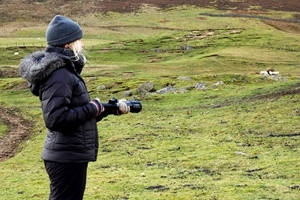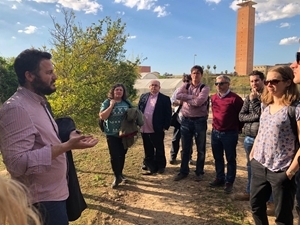 The LIFE-funded LaserFence project, led by Liverpool John Moores University, started in September 2016 with the aim of testing a modified bird-scaring laser device on mammalian pests. The original device, developed by Bird Control Group in the Netherlands, works simply by projecting a small green disc onto the ground close to the target birds; the movement of this disc is sufficient to scare the birds away. If the new Laser Fence system can be adapted to have a similar effect on certain mammals, it might provide a simple alternative to less desirable or more expensive options, such as poison baits and permanent fencing.
The LIFE-funded LaserFence project, led by Liverpool John Moores University, started in September 2016 with the aim of testing a modified bird-scaring laser device on mammalian pests. The original device, developed by Bird Control Group in the Netherlands, works simply by projecting a small green disc onto the ground close to the target birds; the movement of this disc is sufficient to scare the birds away. If the new Laser Fence system can be adapted to have a similar effect on certain mammals, it might provide a simple alternative to less desirable or more expensive options, such as poison baits and permanent fencing.
 The trials are still ongoing but already we have learnt a lot. At GWSDF trials with the handheld device have shown that around 20% of rabbits respond to the laser and it doesn’t make any difference how the laser is moved around. This is relatively low compared to the response amongst birds and future trials are focused on trying to increase this. We have also found that low-powered laser emissions can deter rabbits under low-light conditions – an encouraging result as such a device would have more flexible applications than the higher-powered version, which has restrictions on its use.
The trials are still ongoing but already we have learnt a lot. At GWSDF trials with the handheld device have shown that around 20% of rabbits respond to the laser and it doesn’t make any difference how the laser is moved around. This is relatively low compared to the response amongst birds and future trials are focused on trying to increase this. We have also found that low-powered laser emissions can deter rabbits under low-light conditions – an encouraging result as such a device would have more flexible applications than the higher-powered version, which has restrictions on its use.
Results from some of the other partners are promising too, with squirrels altering their foraging behaviour in response to the laser such that they reduce the amount of time at feeders and delay their return: not the most exciting finding perhaps but an important component that helps us understand the complex behavioural responses these animals are making.
We recently held a partner meeting and a technical seminar at the University of Seville, where we exchanged ideas with researchers from the Higher Technical School of Agricultural Engineering and learnt how the lasers are being used by the project partners in Andalucía in an attempt to protect rice and olive crop

LIFE LaserFence (LIFE15 ENV/UK/000386)
Laser systems for the prevention of food chain poisoning and minimisation of chemical exposure to the environment.
Partner information